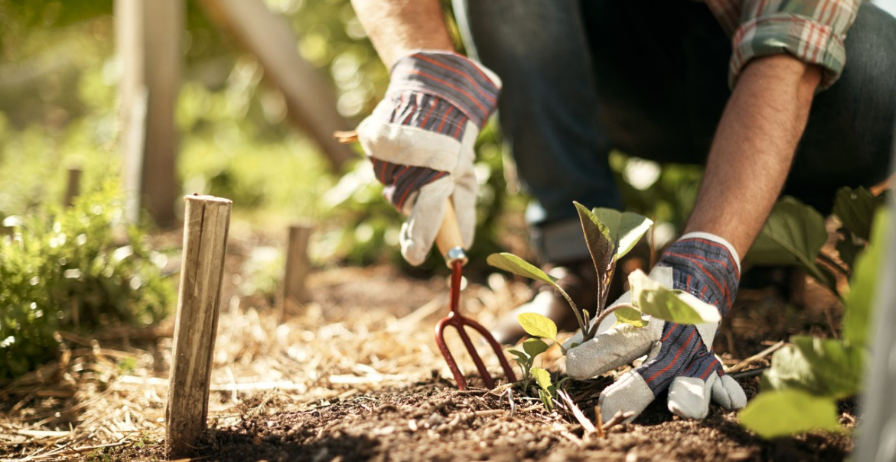Puttering in the garden is an age-old hobby pursued for several reasons; it can keep you fit, provide food and flowers, and help you live in a more beautiful world. Experienced gardeners say mastering a few simple skills can get you off to a productive start to the home garden of your dreams:
Know Your Soil
THE MOST IMPORTANT FACTOR TO CONSIDER IN LANDSCAPING IS THE SOIL!
Before you spend a dime on buying plants, the very first thing you should do is look at your soil. Buying expensive plant will not survive in a poor soil.
So, before you plant, it’s important to know the kind of plants your soil will best support. If you’re new to the neighborhood, ask a neighbor or local county Horticulture Extension Agent if he could make recommendation on what you should do to improve the growing conditions, if needed. A soil test would need to be performed and the agent would give you detailed instructions on how to obtain the samples for testing.
One of the most important elements in landscaping is to determine the soil pH.
Once you know the soil’s pH content, the Extension County Agent will help you choose the food and flowering plants that will thrive in that environment.
You may resourse the Extension Agent through searching for (Your County Name) Extension Service Office.
Seed or Plant Starting
Many gardeners say planting seasonal color (i.e. Annuals) from seed has two big advantages; there are more varieties available as seeds, and it’s far more economical.
It’s fairly easy to save seeds, as well, from one season to the next. A good gardening book can show you how.
Seeds can be planted in micro-greenhouses. For instance: the plastic containers that hold rotisserie chickens from your local grocer are excellent.
Use a good quality, high organic composted soil and make sur to punch several holes in the bottom for drainage.
Sow the seeds heavy on the top of the soil media, lightly cover them. Then after the seeds are sown, place the top back on and place in an are to receive “morning” sunlight.
Puncture one small holes on the top to allow for release of excessive heat and for ventilation.
Water, to the point of feeling damp! Excessive water will rot the seeds.
Container Gardening
You can plant plants in ANY container that can hold soil and provide drainage! From old used tin cans to old boots, wheel barrows … even broken pots. Be creative!
If space is limited, or your soil is less than welcoming, it’s easy to grow vast amounts of food or flowers in containers—and not necessarily in expensive terra cotta pots. Again, use plastic storage tubs, old buckets, whatever.
Cuttings and Transplants
There are many plant types that you can propagate by cuttings. Coleus, oyster plants, hibiscus, liriope, daylilies, iris, bougainvillea, angle trumpet are only a few plants that you can easily propagate.
First, before you make the first cutting is that you make preparations.
Select the area you will be placing the cuttings, whether it is within the landscape or in containers. Make sure you have and area that will provide a site that is in 80-90% shade.
If containers are to be used, fill the containers with a light, organic soil media. DO NOT include any fertilizer at this time! This will cause damage to cuttings.
Next, elect a 4-6 inch piece of the plant (preferably towards the end on the stem). Make sure the piece is strong and ridged but not too woody.
Next, use a clean-blade clipper, by whiping the blade with alcohol and make a 4-6 inch cutting for the desired plant. Make the cut on an 45 degree angle. Then remove 2/3 of the leaves from the bottom of the cutting and immediately place in the soil media and water toughly.
It is very important for the cutting to NOT dry-out! Again, NO fertilizer should be used! The fertilizer will damage the cutting!
Keep the soil media moist every day for a week or so then move the cuttings to an are which receives only morning light and keep them there for 2-3 weeks until they root, then plant them in the garden.
Additional propagating aids can be used, especially wood ornamentals such as rooting hormones. Remember, not all cuttings will survive and with practice the success of survival will increase.
Watering
Plants die from under-watering, but they can die from too much water. Local rainfall will impact your watering schedule and learning proper watering techniques will make you a more successful gardener.
Pruning
While tree pruning is best left to professionals, it’s easy to prune your own roses and other small plants, removing dead or dying parts damaged by insects or weather. Pruning regularly keeps your plants producing and looking healthy.
Tool Maintenance
It’s useless to save by producing tomatoes and such if you spend a fortune replacing garden tools. Choose good rust-proof tools, clean and sharpen them after each use and store them in a dry place and you will have tools that last a lifetime.


